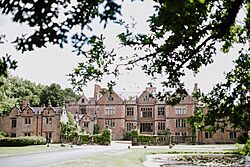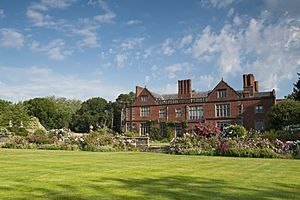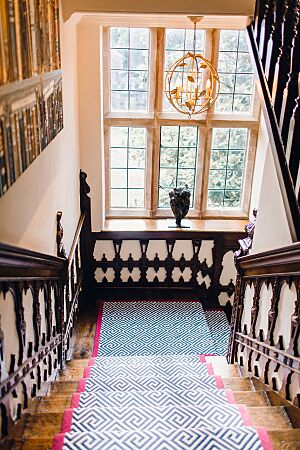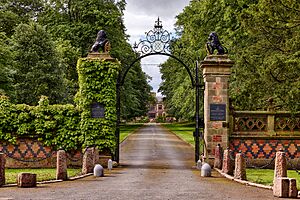Dorfold Hall facts for kids
Quick facts for kids Dorfold Hall |
|
|---|---|

Dorfold Hall: main (front) façade
|
|
| Location | Acton, Cheshire, England |
| Built | 1616–21 |
| Architectural style(s) | Jacobean |
|
Listed Building – Grade I
|
|
| Official name: Dorfold Hall | |
| Designated | 10 June 1952 |
| Reference no. | 1312869 |
| Official name: Dorfold Hall | |
| Designated | 10 June 1985 |
| Reference no. | 1000641 |
| Grade | II |
| Lua error in Module:Location_map at line 420: attempt to index field 'wikibase' (a nil value). | |
Dorfold Hall (SJ635524) is a beautiful old house in Acton, Cheshire, England. It's a Grade I listed building, which means it's very important and protected. The house was built in the Jacobean style, which was popular when King James I was on the throne. Many people think it's one of the best Jacobean houses in Cheshire. The Roundell family owns Dorfold Hall today.
Contents
History of Dorfold Hall
The name Dorfold or Deofold means "place for cattle" or "deer park." This area was not mentioned in the old Domesday survey, but some records say that Edwin, Earl of Mercia, had a hall here a long time ago. A manor at Dorfold was first written about during the time of King Henry III (1216–1272). Over the years, different important families owned the land, including the Wettenhall and Stanley families.
Building the Hall
In 1602, a famous lawyer named Sir Roger Wilbraham bought the estate. He worked for Queen Elizabeth I and King James I. Dorfold Hall was built between 1616 and 1621 for his younger brother, Ralph Wilbraham. It was built on the same spot where the older hall used to be. Later, in 1754, the estate was sold to James Tomkinson, a lawyer from Nantwich.
James Tomkinson hired an architect named Samuel Wyatt to change some of the rooms downstairs. In 1861, the Dorfold Estate went back to the Wilbraham family's descendants. This happened when Anne Tollemache inherited it. Her husband, Wilbraham Spencer Tollemache, became a very important local official in Cheshire in 1865.
Changes and Royal Visits
The gardens and grounds around the hall were redesigned in 1861–1862. During this time, new buildings like the gate lodge were also constructed. In August 1896, a very special guest visited the hall: Princess Louise, who was a daughter of Queen Victoria.
During the Second World War, Dorfold Hall helped people in need. Refugees, mostly from Liverpool, stayed at the hall until November 1940. After that, the park became a camp for Canadian soldiers.
What Dorfold Hall Looks Like
Dorfold Hall is a two-story building made of red brick with stone details. It has a special design with a middle part that is set back and two smaller wings. The house also has very large windows.
Exploring the Grounds
The National Register of Historic Parks and Gardens lists 8 hectares (about 20 acres) of the grounds as Grade II important. The park has a lovely lake.
There's a special gateway near the hall that used to be part of Sir Roger Wilbraham's almshouses in Nantwich. This gate is made of wrought-iron and has a sun design. It stands in a stone opening with statues of King James I and Anne of Denmark. Several other buildings in the park are also listed as important. One of the oldest is an icehouse, which is an underground room made of red brick. It was probably built in the late 1700s to store ice.
When the grounds were redesigned in 1861–1862, several new structures were built that are now listed. The gate lodge on Chester Road is built in the Jacobean style with red brick. The clock tower above the carriage house has stone frames for the clock faces and a wooden weather vane on top. In front of the hall, there's a large iron statue of a mastiff dog with puppies. This statue is thought to be by Pierre Louis Rouillard and came from a big exhibition in Paris in 1855.
The Dorfold Estate
The Dorfold Estate is very large and covers much of the area around Acton. It includes farmhouses, farmland, woods, and historic parkland.
Dorfold Dairy House used to be the main farm for the estate. It's a three-story building made of red brick from the late 1600s and is listed as Grade II* important. The farm building next to it is also listed. Madam's Farm (SJ625525) has always been a working farm. It's a three-story red brick building and is listed as Grade II.
Nantwich and South Cheshire Show
Dorfold Hall Park is famous for hosting the yearly Nantwich and South Cheshire Show. This is a big one-day event that celebrates farming and local products. It has many trade stalls and exciting displays in the main ring. In 2006, about 32,000 people visited the show!
The show also includes the Nantwich International Cheese Awards. This competition started in 1897 and is said to be the biggest cheese exhibition in Europe. In 2007, over 2,250 different cheeses from about 24 countries were entered into the competition.
See also
- Grade I listed buildings in Cheshire East
- Listed buildings in Acton, Cheshire
- List of works by Thomas Harrison






